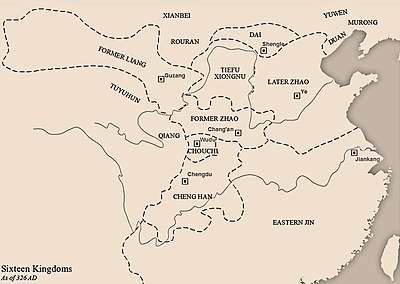Cheng Han
The Cheng Han (simplified Chinese: 成汉; traditional Chinese: 成漢; pinyin: Chénghàn; 303 or 304-347) was a state of the Sixteen Kingdoms during the Jin Dynasty (265-420), situated in what is modern-day Sichuan Province in China.
Cheng Han (成漢) 成 (304-338), 漢 (338-347) | |||||||||
|---|---|---|---|---|---|---|---|---|---|
| 304–347 | |||||||||
 Cheng Han (Cheng) in southwestern China | |||||||||
| Capital | Chengdu | ||||||||
| Common languages | Ba-Shu Chinese | ||||||||
| Government | Monarchy | ||||||||
| Emperor | |||||||||
• 304-334 | Li Xiong | ||||||||
• 334 | Li Ban | ||||||||
• 334-338 | Li Qi | ||||||||
• 338-343 | Li Shou | ||||||||
• 343-347 | Li Shi | ||||||||
| History | |||||||||
• Li Te's change of Jin Dynasty era name | 303 | ||||||||
• Li Xiong's claim of princely title | 304 | ||||||||
• Li Xiong's claim of imperial title | 306 | ||||||||
• Name change to Han | 338 | ||||||||
• Disestablished | 347 | ||||||||
• Li Shi's death | 361 | ||||||||
| Currency | Chinese cash coins (Ancient Chinese coinage) | ||||||||
| |||||||||
| Today part of | China | ||||||||
It represented two states, the Cheng state (成, pinyin Chéng) proclaimed in 304 by Li Xiong and the Han state (汉, pinyin Hàn) in 338 by Li Shou. Since they were both ruled by the Li family of the Ba ethnicity,[1] scholars with Chinese backgrounds often combined them into a single Cheng Han state. (The Li family has also been described as being of Ba-Di ethnicity, they were originally Ba from modern Sichuan who had settled among the Di in modern Gansu.)[2] Western texts frequently referred to the two states separately. Whether the treatment is correct is debatable—when Li Shou claimed the throne in 338, he did not acknowledge his throne as having been inherited from Li Xiong's line, and indeed, while continuing the worship of Li Xiong, maintained it in a separate temple. Li Shou's son Li Shi, however, acknowledged the prior emperors as his predecessors. Cheng Han's was the earliest establishment of the Sixteen Kingdoms.
All rulers of the Cheng Han declared themselves "emperors".
The commonly accepted founding year of Cheng has been 304. Nevertheless, Li Te declared a new era name in 303 and self-declaration of era name has been considered by some Chinese scholars to be a symbol of a new government. At that time, however, Li Te claimed no imperial or other special titles for himself.
Rulers of the Cheng Han
| Temple name | Posthumous name | Personal name | Durations of reign | Era names |
|---|---|---|---|---|
| Cheng 303 or 304-338 | ||||
| Shizu | Jing | Li Te | 303 | Jianchu (建初) or Jingchu (景初) 303 |
| – | – | Li Liu | 303 | – |
| Taizong | Wu | Li Xiong | 303-334 | Jianxing (建興) 304-306 Yanping (晏平) 306-311 Yuheng (玉衡) 311-334 |
| – | – | Li Ban | 334 | Yuheng (玉衡) 334 |
| – | – | Li Qi | 334-338 | Yuheng (玉恆) 335-338 |
| Han 338-347 | ||||
| Zhongzong | Zhaowen | Li Shou | 338-343 | Hanxing (漢興) 338-343 |
| – | – | Li Shi | 343-347 | Taihe (太和) 343-346 Jianing (嘉寧) 346-347 |
Emperors' family tree
| Cheng Han | ||||||||||||||||||||||||||||||||||||||||||||||||||||||||||||||||||||||||||||||||||||||||||||||||||||||||||||||||||||||||||||||||||||||||||||||||||||||||||||||||||||||||||||||||||||||||||||||||||||||||||||||||||||||||||||||||||||||||||||||||||||||||||||||||||||||||||||||||||||||||||||||||||||||||||||||||||||||||||||||||||||||||||||||||||||||||||||||||||||||||||||||||||||||||||||||||||||
|---|---|---|---|---|---|---|---|---|---|---|---|---|---|---|---|---|---|---|---|---|---|---|---|---|---|---|---|---|---|---|---|---|---|---|---|---|---|---|---|---|---|---|---|---|---|---|---|---|---|---|---|---|---|---|---|---|---|---|---|---|---|---|---|---|---|---|---|---|---|---|---|---|---|---|---|---|---|---|---|---|---|---|---|---|---|---|---|---|---|---|---|---|---|---|---|---|---|---|---|---|---|---|---|---|---|---|---|---|---|---|---|---|---|---|---|---|---|---|---|---|---|---|---|---|---|---|---|---|---|---|---|---|---|---|---|---|---|---|---|---|---|---|---|---|---|---|---|---|---|---|---|---|---|---|---|---|---|---|---|---|---|---|---|---|---|---|---|---|---|---|---|---|---|---|---|---|---|---|---|---|---|---|---|---|---|---|---|---|---|---|---|---|---|---|---|---|---|---|---|---|---|---|---|---|---|---|---|---|---|---|---|---|---|---|---|---|---|---|---|---|---|---|---|---|---|---|---|---|---|---|---|---|---|---|---|---|---|---|---|---|---|---|---|---|---|---|---|---|---|---|---|---|---|---|---|---|---|---|---|---|---|---|---|---|---|---|---|---|---|---|---|---|---|---|---|---|---|---|---|---|---|---|---|---|---|---|---|---|---|---|---|---|---|---|---|---|---|---|---|---|---|---|---|---|---|---|---|---|---|---|---|---|---|---|---|---|---|---|---|---|---|---|---|---|---|---|---|---|---|---|---|---|---|---|---|---|---|---|---|---|---|---|---|---|---|---|---|---|---|---|---|---|---|---|---|---|---|---|---|---|---|---|---|---|---|---|---|---|---|---|---|---|---|---|---|---|---|---|---|---|---|---|---|---|---|---|---|---|
| ||||||||||||||||||||||||||||||||||||||||||||||||||||||||||||||||||||||||||||||||||||||||||||||||||||||||||||||||||||||||||||||||||||||||||||||||||||||||||||||||||||||||||||||||||||||||||||||||||||||||||||||||||||||||||||||||||||||||||||||||||||||||||||||||||||||||||||||||||||||||||||||||||||||||||||||||||||||||||||||||||||||||||||||||||||||||||||||||||||||||||||||||||||||||||||||||||||
See also
- Ba
- Di (Wu Hu)
- List of past Chinese ethnic groups
- Wu Hu
- Sixteen Kingdoms
- Huan Wen
- Sichuan
- Eight Immortals from Sichuan
References
Citations
- Kleeman, 2.
- Holcombe, Charles (2001). The Genesis of East Asia, 221 B.C.-A.D. 907. University of Hawaii Press. p. 24. ISBN 0-8248-2465-2.
Sources
- Kleeman, Terry F., Great Perfection: Religion and Ethnicity in a Chinese Millennial Kingdom, ISBN 0-8248-1800-8.